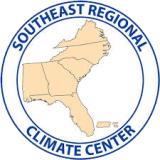Southeast Climate Monthly Webinar: February 27, 2024
El Niño reached “very strong” intensity during the winter months and impacted weather and climate patterns across the Southeast as anticipated. Increased precipitation events and storminess resulted in the elimination of drought across most of the region and produced widespread minor flooding and numerous moderate and major floods over the last month. Looking ahead, river flood risk is expected to stay above normal as we approach spring and El Niño continues to keep the southeast U.S. active.
Check out the video recording and summary to learn more about Southeast climate conditions and a special presentation, "The Fifth National Climate Assessment: Southeast” from Jeremy Hoffman of Groundwork USA. For more information, please contact Meredith Muth (meredith.f.muth@noaa.gov).
About This Webinar
The Southeast Climate monthly webinar series is hosted by the Southeast Regional Climate Center, the National Integrated Drought Information System (NIDIS), and the NOAA National Weather Service. These webinars provide the region with timely information on current and developing climate conditions such as drought, floods, and tropical storms, as well as climatic events like El Niño and La Niña. Speakers may also discuss the impacts of these conditions on topics such as agriculture production, water resources, wildfires, and ecosystems







